Birdwatching is fun, especially for bird lovers but it is also not for everyone. Only real enthusiasts ready to fill their heads with nuanced knowledge about the behavior and appearances of the different bird types and can make extended observations on them can pursue it.
I assume you are an early birdwatcher and can’t seem to identify these beautiful birds with white bellies. It is no topic of shame that you can’t tell which bird it is because there are so many. It can be a black phoebe, a Carolina chickadee, an eastern towhee, a dark-eyed junco, a king penguin, an Atlantic puffin, a razorbill, a black-and-white warbler or a hairy woodpecker.
I will help you learn about 14 black birds with white bellies in this article. We will learn about their basic behavior, general size and appearance, and common habitat.
1. Dark-eyed Junco (Small North American Bird)
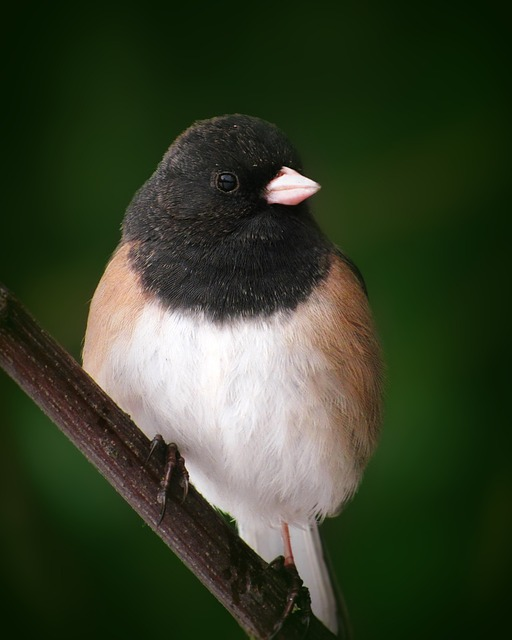
Size & Body Structure
Males and females of this bird species weigh an average of 0.67 ounces as adults and range in body length from 4.9 to 6.5 inches. They exhibit a more upright stance and have rounder head profiles.
Behavior
Dark-eyed Juncos nibble or claw at discards on the ground as they search for food. They typically move in tiny social groups by hopping or strolling; they seldom run unless they are chasing something. If they see bugs on tree trunks, they will occasionally fly upward.
Color
This species exhibits significant regional color diversity. Western males often have a black hood, a cinnamon mantle, white underparts, and beige sides.
The eastern male’s have gray head, upper breast, sides, and dark gray upperparts, whereas the lower breast and belly are white. Both versions feature a pink beak, a dark gray tail, and noticeable white outer tail feathers when flying.
Where to Find Them
They may be found at elevations between sea level and above 11,000 feet throughout North America. They may be found in deciduous woods like aspen, cottonwood, oak, maple, and hardwood and coniferous forests like fir, Douglas-fir, juniper, and fir.
They utilize a larger range of habitats, such as open forests, grasslands, roadside vegetation, playgrounds, and lawns, throughout the winter and while migrating.
2. Black Capped Chickadee
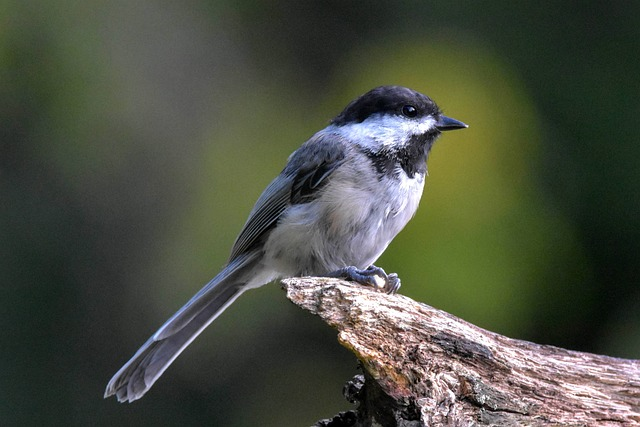
Size & Body Structure
This bird features a wide head and a short neck, which give it a definite spherical form. Its beak is shorter and thicker, while its tail is longer and narrower. Adults measure in length between 12 to 15 cm. They weigh around 9 to 14 g, and their wingspan is around 16 to 21 cm.
Behavior
These small birds often move in small flocks and use their sounds to communicate danger, food locations, and “all clear” signals.
In order to take advantage of the chickadees’ alertness and caution, many other tiny birds, including warblers, nuthatches, and titmice, travel in their company.
Chickadees are regarded as amiable birds since they get along well with other little songbirds and don’tdon’t exhibit much fear of people.
Color
As its name indicates, this chickadee has white sides and a black crown and collar. The Black-capped Chickadee has a velvety gray back and wings with white borders on the gray plumage.
The black-capped chickadees’chickadees’ eyes are obscured by its long black hat extending to their faces and eyes. They have white-grading underparts that are velvety and buffy.
Where to Find Them
Black-capped Chickadees live in a variety of deciduous woodlands and open woods. They are found in mixed and deciduous woods.
These birds are simple to identify among trees or at feeding stations. They enjoy weedy fields, cattail marshes, wooded areas, and woodlots.
3. Black-billed Magpie
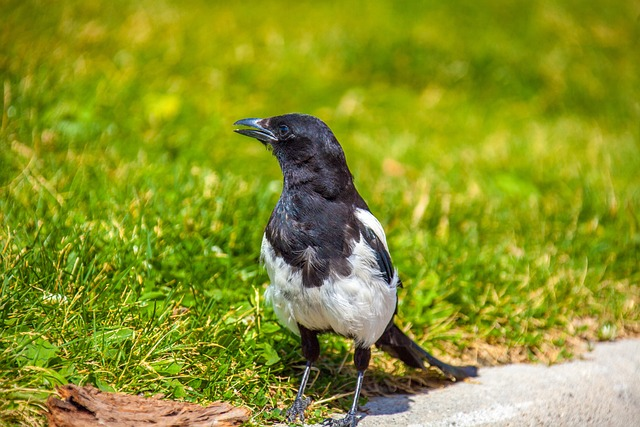
Size & Body Structure
Mid-sized black-billed magpies have a long tail that can make up nearly half of their length. Their length varies from 45 to 60 cm, and their wingspan is between 56 and 61 cm. Magpies with black bills weigh between 145 and 210 g.
Behavior
Black-billed magpies have a macho stride and may hop before taking flight. While descending flight is often composed of a brief succession of wing flaps interrupted with intervals where the flaps are drawn tightly to the body, horizontal flight typically consists of slow, continuous wing beats. This alternating pattern produces a unique J-shaped flying trajectory.
Color
Black coloration adorns black-billed magpies’ heads, upper breasts, back, and tails. On the lower breast and wings, there are substantial white spots.
Both their legs and thick black bills are black. The tail, body, and wings of black-billed magpies appear primarily black and white from a distance, but under the right lighting, their wings and tails will glimmer with a stunning blue-green iridescent flashes.
Males and females have comparable colorations. However, females are roughly 10% smaller than males in size.
Where to Find Them
Western North America is home to the black-billed magpie. They often live in rangelands and forested areas with open fields, frequently adjacent to water.
Additional habitat requirements include bushes and trees that can support their unusually large nests.
In coastal and riparian ecosystems, these requirements are typically satisfied. These similar characteristics make farm sites and agricultural regions great habitats, which makes rural people settlements.
4. Carolina Chickadee (Small Gray Bird With White Bellies)

Size & Body Structure
The Carolina chickadee has a wingspan of around 4.5 inches. These birds feature a big face, a short neck, and a little, chubby body.
Behavior
In the winter, flocks of Carolina Chickadees cluster together. Each flock individual has a ranking, and once springtime comes around, the highest ranking members will nest inside the flock’s domain.
Lower-ranking birds must fly further to claim a territory properly; many do not nest that season.
Color
Chickadees have white underparts and cheeks. The flanks and rear have a buffy hue, while the feathers and tail are a paler shade of gray.
Both young and adult Carolina chickadees exhibit the same traits, albeit youngsters have a somewhat duller hue. Males are a little bit larger than females.
Where to Find Them
These birds can frequently be seen in open deciduous forests, mixed woodlands, clearings in the woods, the boundaries of the woods, and parks in suburban and urban areas.
They prefer to establish their nests in lower altitudes and do not enjoy visiting backyard feeders.
5. Downy Woodpecker
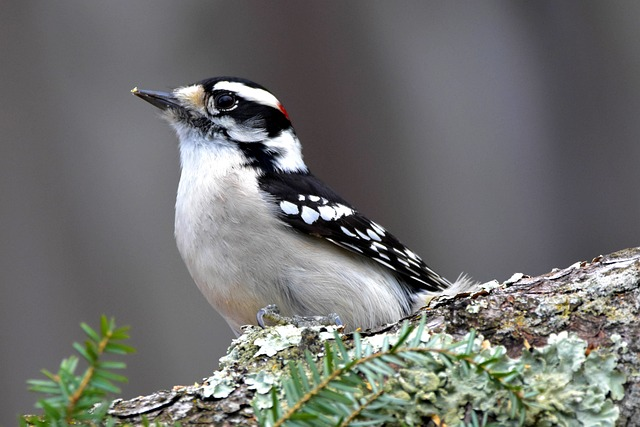
Size & Body Structure
Downy Woodpeckers are the tiniest of woodpeckers and are endemic to North America. They are 14.5–17 cm long and 21–28 g in weight. They are similar in structure to the hairy woodpecker, and that’s why they are confused with them frequently.
Behavior
The downy woodpecker is a nocturnal, non-migratory bird. Although they occasionally eat seeds in scattered groups, they are independent. Males protect their territories from other males, and females protect their territories from other females.
When a downy woodpecker’swoodpecker’s territory is invaded, the incumbent woodpecker will attempt to scare the invader away by making threatening demonstrations such as wing flicks, spreading the tail, elevating the crest, and sticking up the bill.
Color
They are primarily black and white; their wings have white spots on them, and their backs are black with a white stripe down the middle.
A white stripe is visible both above and below each eye on the black skull. The tail is banded with black and white on its furthest sections. These birds have white chest and gray-colored skin that covers belly.
Where to Find Them
Downy woodpeckers prefer the wide deciduous woodlands and forests as habitat. Orchards and other agricultural areas are popular habitats and can even be seen sometimes in urban and suburban areas.
They often hang out in damp aspen-willow forests or riparian woodlands in the south of North America. They can be expected in the southern Rocky Mountains sometimes too.
6. Rose Breasted Grosbeak
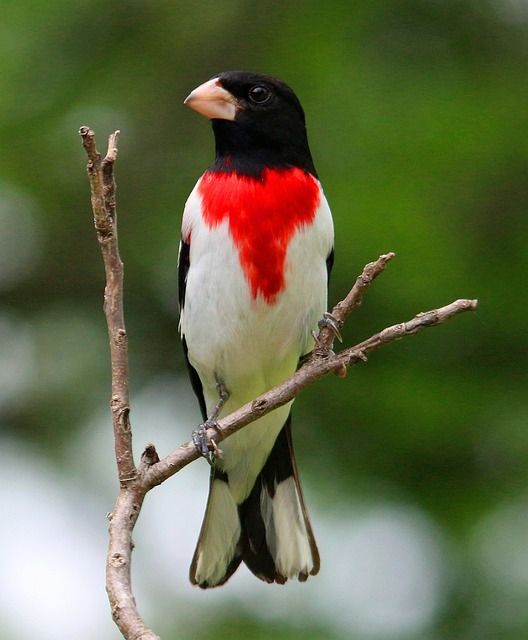
Size & Body Structure
Rosy-breasted grosbeaks weigh between 39 and 49 grams and measure 18 to 21.5 cm in length. They are relatively small-sized streaky birds.
Behavior
They often travel by themselves or in small flocks at night. The flying path of rose-breasted grosbeaks includes hopping on the ground.
When scared, they frequently stop, flail their wings, stretch their tails, lift the feathers on their heads, and run towards a potential threat. During the mating season, pairs drive out rival individuals of other birds of the species.
Color
Both the male and female rose-breasted grosbeaks have distinctive colour patterns. Males have a rose neck and a white abdomen and breast, in addition to having a black head, white beak, black and white dorsally, and a black and white dorsum.
Females have brown skin with white patterns above and buffy skin with brown stripes on the belly, chest, and neck.
Where to Find Them
Rose-breasted grosbeaks may be found in a broad range of forested environments, such as swampy or wet woods, forests next to rivers and lakes, and woodlands on the forest edges.
They like open, mixed-deciduous forests, such as second-growth habitats, over those with a closed structure. They appear to stay away from meadows and dry forests.
7. Blackpoll Warbler
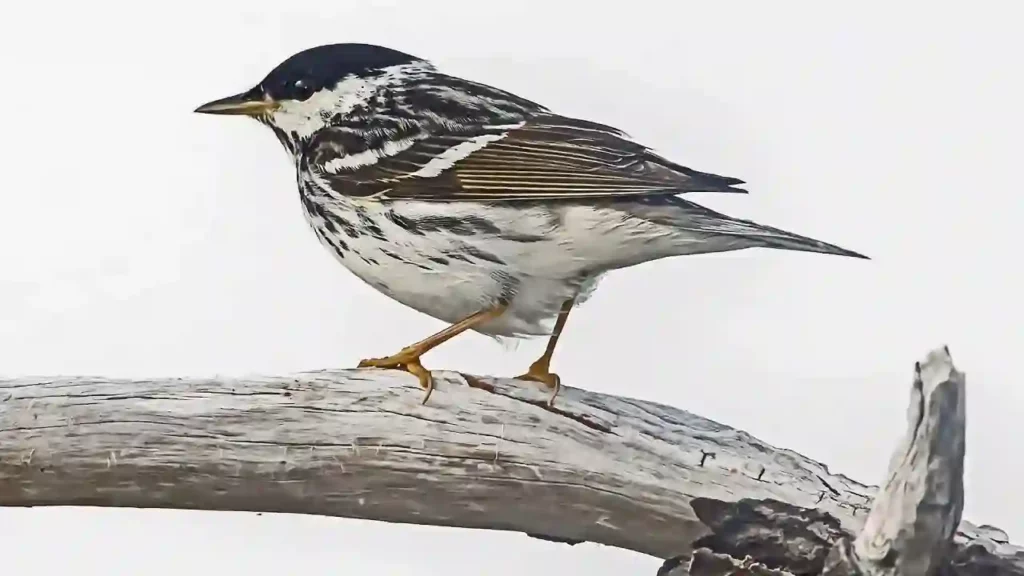
Size & Body Structure
The body weight range of a blackpoll warbler is 7.8 to 22.1g, and its length is around 14cm. Their wingspan varies from 18 to 26 mm.
Behavior
Blackpoll warblers are nocturnal migratory birds; however, they can migrate during the day on longer journeys. They will migrate in mixed groups of different species to protect themselves from larger birds and increase their chances of finding food.
Due to the lower availability of resources in the fall, they forage more quickly while migrating in the spring.
Color
While the flanks of these birds have noticeable black stripes, the belly, breast, and throat are all white. The top tail coverts of this warbler are olive-gray upper parts with black stripes, and it has two striking white wing bars.
Females don’t have a black cap or a malar stripe as men of the species have. They have black and white crest and stripes on their dorsal side. Their abdomen and breast contain some streaks, and their bodies are white with a yellow splash.
Where to Find Them
They inhabit a wide variety of environments, mostly in tamarack and spruce tree zones. These areas include mangrove forests, oak-hickory woods, dry forests, and wet thickets. They may be found in any vegetated area but are more prevalent in alpine environments.
Blackpoll Warblers often attain a maximum altitude of 3,000m over their migratory journeys.
During the winter, these warblers spend time in cloud forests, lowland forest borders, and deciduous forests in forested settings.
8. Black Phoebe

Size & Body Structure
Black phoebes are little songbirds with long tails, chubby bodies, and huge heads. Their bill is lengthy yet slender. American Goldfinches are smaller than black phoebes, while scrub jays are much bigger.
They weigh between 0.5 to 0.8 ounces and range in length from 6.3 inches to 6.4 inches. Their range of wingspans is 10.5–11 inches.
Behavior
When perching, they stand straight up and continually pump their tail up and down. They love to sit close to water features and shoot fast darts to grab flying insects as they pass overhead.
They hunt by keeping an eye on their target and then shooting fast darts or hovering to collect and eat insects off the vegetation.
Color
For the most part, the face, upper parts, and chest of black phoebes are covered with black plumage. They have white undertails and stomachs in contrast to the black of the head.
The color of the beak, legs, and eye is also black. The margins of their wings are gray, and their crest is darker than the remainder of their upper parts.
Where to Find Them
Black Phoebes are common throughout Western America. They have their breeding range from southwest Oregon and California toward Central and South America.
Although most Black Phoebes live permanently, their northern populations do some seasonal migration. The northern colonies of these birds travel southward to lower levels during the autumn.
9. Eastern Towhee

Size & Body Structure
These birds come in various shapes and sizes depending on their species.
With a wing span of approximately nine to ten inches, eastern towhees are the biggest species in the genus. They have rust-colored flanks and black tails with white bellies. While females have brown feathers, males have black backs.
Eastern towhee lengths range from 6 to 9 inches.
Behavior
Most of the time, these birds live alone, and they even exhibit indications indicating when they wish to be left alone. For instance, males may twitch their tails and lower their wings to signal that someone is unwanted.
Additionally, males are extremely territorial and take extra precautions to protect their homes.
Color
Eastern Towhees have varied appearances in males and females. In contrast to the female, who is rich brown, the male is all black, including his hood and upper gray body.
Both birds have a long tails with noticeable white dots on the outside corners of the plumage, are white below, have scarlet (reddish) flanks, and have a white band on the wing.
Where to Find Them
These birds live in a variety of environments, including urban areas, forests, and woods.
Although they can survive at elevations up to 6,500 feet, they prefer lower elevations because of the warmth.
They spend most of their time on the ground, searching the vegetation for food, particularly flourishing in regions with dense undergrowth.
10. Tree Swallow

Size & Body Structure
Tree swallows are little creatures; however, compared to other swallows, they are moderately sized. They vary in size from 4.7 to 5.5 inches in length, and their wingspan is 11.8 to 13.8 inches. Typically, these small gray birds will weigh somewhere between 0.6 and 0.9 ounces.
Behavior
Tree swallows are extremely social birds that travel in groups of more than 100,000 birds. Other than during the mating season, these species can also be found in great numbers. The mating season is when these sociable birds become fiercely possessive.
Both male and female fiercely defend the 50–60 feet of space that surrounds their nests. Tree Swallows typically congregate for nocturnal roosting.
Most of the behavior of Tree Swallows is caused by competition for breeding places.
Color
Their feathers and tails are sooty grays with a little emerald lustre, and sooty gray upper body with a subtle silky gloss.
The underparts of their juvenile ones are dull white and substantially less smooth than the underparts of adults, and their breasts are gray brown.
Both male and female resemble one another when they are young; however, males may have somewhat shinier plumage.
Where to Find Them
Due to the availability of nest boxes, Tree Swallows, who historically solely inhabited wooded areas due to their requirement for tree cavities for nesting, are now able to be found in open settings.
These birds typically locate nesting cavities in dead trees, abandoned woodpecker holes dug in living trees, and beneath structures.
Wetlands, coastlines, meadows, forested swamps, beaver lakes, and farms are among the habitats that Tree Swallows inhabit.
11. Blue Gray Gnat Catcher

Size & Body Structure
The blue-gray gnatcatcher is a tiny, long-tailed songbird that measures just 4.5 inches in length and weighs only 0.3 ounces.
Its breast is pale gray while its back is dark blue-gray with white wing bars. The tail of the bird is usually held erect, which makes it look like an upside-down “V”.
Behavior
Blue-gray gnatcatchers are quite active, often flitting from one branch to another. They feed mostly on insects, including spiders and caterpillars, which they catch in flight. They also consume some fruits, particularly during the winter months.
These birds typically live alone or in pairs throughout the year, though they may gather in small flocks of up to 20 birds during migration.
Color
The blue-gray gnatcatcher’s distinctive coloration is easy to identify. The upperparts are a dark steel-blue with two white wing bars and the underparts are a pale grayish white. Additionally, the forehead, lores, and a stripe above the eyes are black. The tail is dark gray, and the legs and bill are black.
Where to Find Them
Blue-gray gnatcatchers live in dense shrubbery and woodlands throughout much of North America from southern Canada to northern Mexico.
They are usually found in low woodland areas near both fresh and saltwater marshes, scrubby forests, and along the edges of open fields.
They prefer moist habitats with dense shrubbery where they can forage for their insect prey. These birds also nest in trees and shrubs, typically at heights of 6–15 feet above ground.
12. Mountain Chickadee

Size & Body Structure
The mountain chickadee is a tiny bird that measures just 4.7 inches in length and weighs only 0.5 ounces. Its body is round with a short, notched tail and its wings are rounded and broad. The head of the bird is blackish-gray with white stripes over the eyes and a white throat.
Behavior
Mountain chickadees are quite active and often seen foraging in groups of up to twenty birds. They feed mostly on insects, spiders, and other small invertebrates, which they catch in flight or glean from trees and shrubs.
Mountain chickadees also consume some seeds and fruits when available. These birds typically live in small family groups during the breeding season, while they may gather in larger flocks of up to fifty birds during migration and winter.
Color
The mountain chickadee has a distinctive coloration that is easy to identify. The head and back are blackish-gray with white stripes over the eyes, and the throat and breast are white. The wings and tail are dark gray, and the belly is light gray. The legs and bill are black.
Where to Find Them
Mountain chickadees live in the mountainous regions of western North America from British Columbia in Canada down to California, Arizona, and New Mexico in the United States.
They inhabit coniferous forests, aspen groves, and open woodlands at elevations of 4,000–11,000 feet.
Mountain chickadees also nest in trees and shrubs, typically at heights of 6–15 feet above ground.
These birds are often seen foraging on the edges of dense conifer stands or along logging roads. They may also be found in parks and residential areas with trees.
13. European Crested Tit

Size & Body Structure
The European crested tit is a small songbird that measures just 4.7 inches in length and weighs only 0.4 ounces. Its body is round with a short, notched tail and its wings are rounded and broad.
The head of the bird is grayish-brown with an orange crest on the forehead and has white cheeks.
Behavior
European crested tits are quite active and often seen foraging in pairs or small family groups. They feed mostly on insects, spiders, and other small invertebrates, which they catch in flight or glean from trees and shrubs.
European crested tits also consume some seeds and fruits when available. These birds typically live in pairs during the breeding season, while they may gather in larger flocks of up to fifteen birds during migration and winter.
Color
The European crested tit has a distinctive coloration that is easy to identify. The head and back are grayish-brown with an orange crest on the forehead and a white patch on the cheeks.
The wings and tail are dark gray, and the underparts are white with variable amounts of black mottling. The legs and bill are black.
Where to Find Them
European crested tits live in coniferous forests throughout central and southern Europe from Norway down to France, Italy, and Greece. They inhabit coniferous forests, scrubby woodlands, and open habitats at elevations of up to 2,300 feet.
European crested tits are often seen foraging in the lower branches of conifers or along logging roads. They may also be found in parks and residential areas with trees.
14. The Tufted Titmouse

Size & Body Structure
The tufted titmouse is a small songbird that measures just 4.7 inches in length and weighs only 0.5 ounces. Its body is round with a short, notched tail and its wings are rounded and broad. The head of the bird is grayish-brown with an orange crest on the forehead and a black patch on either side of the face.
Behavior
Tufted titmice are quite active and often seen foraging in small family groups. They feed mostly on insects, spiders, and other small invertebrates, which they catch in flight or glean from trees and shrubs.
Tufted titmice also consume some seeds and fruits when available. These birds typically live in small family groups during the breeding season, while they may gather in larger flocks of up to fifty birds during migration and winter.
Color
The tufted titmouse has a distinctive coloration that is easy to identify. The head and back are grayish-brown with an orange crest on the forehead and a black patch on either side of the face.
The wings and tail are dark gray, and the underparts are white with variable amounts of yellow or buff mottling. The legs and bill are black.
Where to Find Them
Tufted titmice live in forests throughout eastern North America, ranging from Maine to Minnesota and south to Texas, Oklahoma, Arkansas, Mississipp
They inhabit deciduous and mixed forests at elevations of up to 4,000 feet. Tufted titmice are often seen foraging in the lower branches of trees or along forest edges.
They may also be found in parks and residential areas with trees. They will occasionally visit bird feeders, particularly during winter months.
Final Thoughts on Black and Gray Birds With White Bellies
I hope the information given in this article has armed you with enough knowledge, and you will be able to immediately tell the type of black bird with a white belly the next time you spot one. As you learned, there are a variety of such birds in North America alone, and while you have found about ten of them in this post, we could have mentioned at least 30 such birds.
As a birdwatcher, the next time you see a black bird with a white belly, observe the bird carefully and consider the markings, color patterns, size and behavior to identify it spot on.
Sources:
- allaboutbirds.org
- birdsoftheworld.org
- audubon.org
- wikipedia.org



